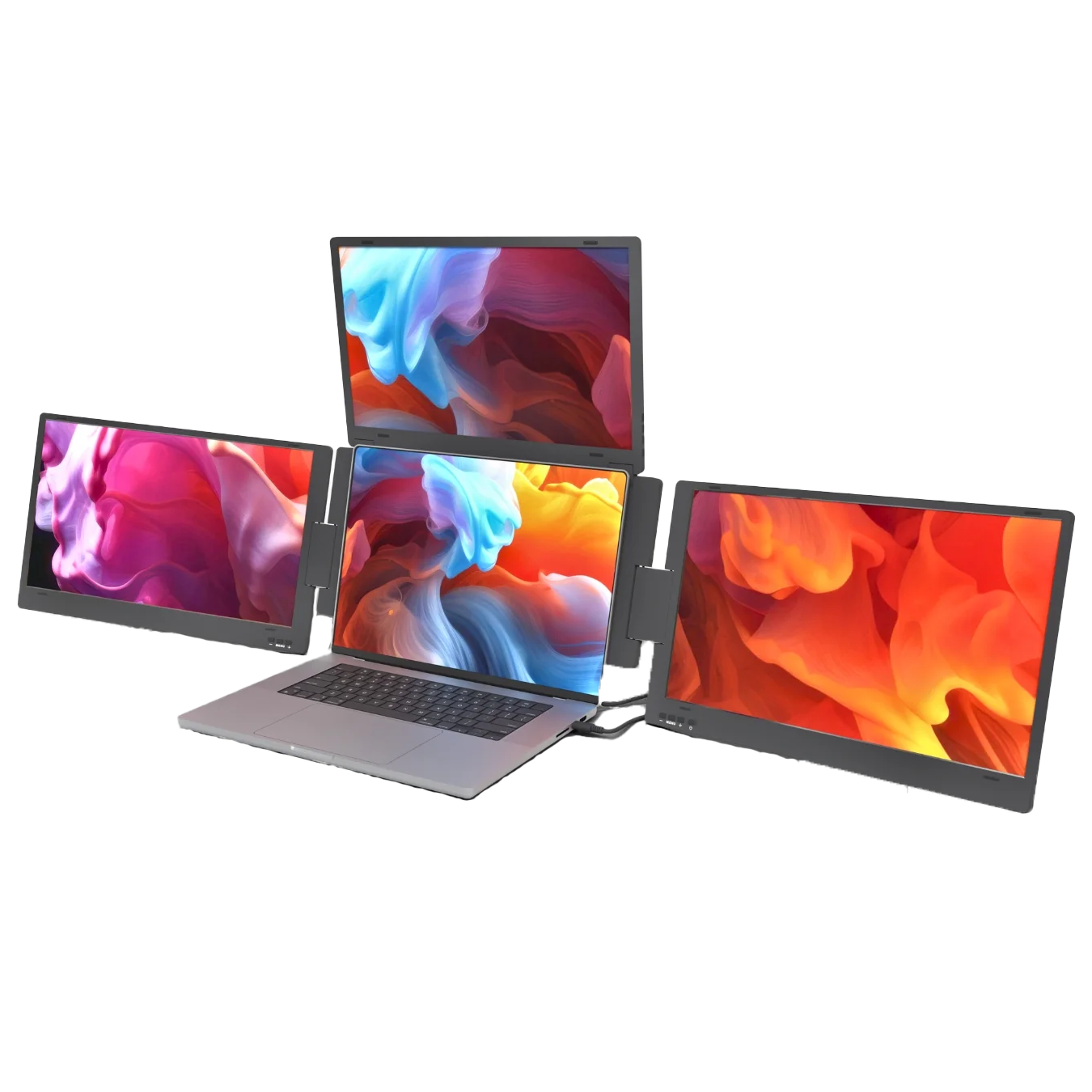When Aura Displays reached out about the Triple Boost 14 Pro, I was immediately curious to see what it was about. It's been a while since I've had the chance to test a portable monitor, but I love the idea. A couple of years ago, I reviewed an interesting concept of a dual portable monitor that seemed to be very promising, though it fell short in a few ways. So, I wanted to know how far we've come in that time.
I was not prepared for how much of a leap this was compared to my previous experience. The Triple Boost 14 Pro is an overkill setup for the majority of mobile workers, but if you need a lot of screens and you need them anywhere, this is an amazing solution that's frankly not as expensive as I thought it would be.

Related
The Portable Monitor Slide V2 review: Two screens you can (kind of) take anywhere
Want a triple-screen setup on the go? The Portable Monitor Slide V2 delivers that, if you can deal with the hassle of setting it up.
It's not without its flaws, but everything comes together in this package to offer a really solid experience that's easy to recommend if you're in the niche of people who need to maximize their productivity.
About this review: Auro Displays sent us the Triple Boost 14 Pro for this review. The company had no input on its content.

Screen Size 14-inch (per screen)
Display Technology IPS
HDR No
The Triple Boost 14 Pro gives you three extra screens when working with a laptop, taking your productivity to a whole new level. With premium build quality, great screens, and a simple connection, this is one of the best options of this kind, and it's not overly expensive, either.
Pros & Cons
- Three displays help you be much more productive
- The displays are actually solid
- Build quality is surprisingly good for the price
- Big and heavy
- Displays aren't fully protected when the device is closed
- Some connection interruptions tend to happen
Aura Display Triple Boost 14 Pro: Pricing and availability
The Triple Boost 14 Pro became available to order in mid-May, and you can get it from the official Aura Displays website. It's not available anywhere else at this time.
Official pricing on the website shows the Triple Boost 14 Pro costs $649 as the standard, though we're seeing a discount to just $469 at writing time.
Resolution 1920x1080 (per screen)
Refresh Rate 60Hz
Screen Size 14-inch (per screen)
Ports 1x USB-C (power delivery only), 1x USB-C (power and data)
Display Technology IPS
Aspect Ratio 16:9 (per screen)
Screen Brightness 300 nits
Dimensions 13.8x8.1x1.3 inches (353x208x35 mm)
Weight 4.7 pounds (2.2 kilograms)
Mounting Options Included stand
Sound None
HDR No
Variable Refresh No
Price $649
A huge boost in productivity
Getting more done with more screens
The benefits of the Triple Boost 14 Pro are immediately apparent, especially if you've used dual monitors at home. This beast of an accessory gives me three screens in one package, and if you think that makes for a less-than-portable setup, you're kind of right.
Make no mistake, this is a pretty big accessory, and 4.7 pounds is not a subtle weight to add to your backpack. But consider this: the Slide V2 portable monitor I reviewed back in September 2023 had just two 13.3-inch screens, and it was almost as heavy at 4.41 pounds, albeit it was significantly thinner. However, it also had pretty bad build quality and overall just felt like a prototype in many ways.
The Triple Boost 14 Pro looks and feels premium. The entire chassis is made of aluminum, and it feels very sturdy. The built-in kickstand also feels durable, and deploying it feels smooth, plus it has rubber feet to avoid scratching whatever desk you put it on. Opening the displays is also easy and fairly intuitive, and you get built-in controls for all of them, so you can change things like brightness for each individual screen. Everything just feels more refined and well thought out than my previous experience with something like this. Granted, other portable monitors have appeared with great build quality, but for me, this was a huge step up.
Adding three displays to my laptop radically changed what I can do with it. I went from juggling app windows on one small screen to having everything I need visible at all times. I write on my main screen, have a Discord call running on another (I need some social interaction to keep me sane while working from home), my messaging apps on another, and some reference material and task management on the final screen. If I need to reference even more things, I can also just open another tab on my Discord screen. This is even more space than I'm used to having on my desktop, but the lower resolution of the displays compared to my desk monitor also warrants having more of these apps in full-screen, so it balances out. Put simply, this is the most productive I can imagine being on a laptop. With a proper mouse, I almost didn't miss my primary setup when I switched to this one full-time.

Related
Acer dual portable monitor (PD163Q) review: Are two screens one too many?
This accessory gives you two extra 15.6-inch displays on the go — the question is whether you really need that much screen space.
The Triple Boost 14 Pro doesn't force you to use all three displays at once, or to have them all face you. You can use just the two side screens if that's all you need, and even flip them all the way back to form a triangle if you're using them to share content with people around you. I had no use for this, so I stuck to my quad-display setup, and it was amazing.
They're good screens, too
Vivid colors and fairly bright

To make the Triple Boost 14 Pro a great product, it helps that the screens themselves are also quite solid. They don't get incredibly bright, but you're also not going to be pulling this out in public unless you want to invite stares. This is for using back in an office or back in the hotel room after a day running around a trade show. And for that kind of use, they're perfectly fine, though they are a bit too reflective. I sat right next to my living room window while testing this, and I wound up closing my blinds about halfway, just so I didn't have to max out the brightness on the screens.
Aura Displays advertises up to 300 nits of brightness, and my tests come just shy of that. I measured all three displays with my SpyderX Pro to check for consistency, so here's what I got:
|
sRGB: 100% Adobe RGB: 76% P3: 76% NTSC: 70% |
sRGB: 100% Adobe RGB: 76% P3: 76% NTSC: 70% |
sRGB: 100% Adobe RGB: 75% P3: 76% NTSC: 70% |
|
Brightness: 44.3 Black: 0.04 Contrast: 1000:1 White Point: 7200K |
Brightness: 44.8 Black: 0.04 Contrast: 1010:1 White Point: 6900K |
Brightness: 43.3 Black: 0.04 Contrast: 970:1 White Point: 6900K |
|
Brightness: 114.6 Black: 0.10 Contrast: 1100:1 White Point: 7200K |
Brightness: 117.1 Black: 0.10 Contrast: 1130:1 White Point: 6900K |
Brightness: 112.6 Black: 0.10 Contrast: 1080:1 White Point: 7000K |
|
Brightness: 184.0 Black: 0.16 Contrast: 1120:1 White Point: 7300K |
Brightness: 188.5 Black: 0.16 Contrast: 1150:1 White Point: 7000K |
Brightness: 181.2 Black: 0.15 Contrast: 1220:1 White Point: 7000K |
|
Brightness: 232.2 Black: 0.19 Contrast: 1200:1 White Point: 7300K |
Brightness: 238.0 Black: 0.19 Contrast: 1230:1 White Point: 7000K |
Brightness: 228.6 Black: 0.19 Contrast: 1180:1 White Point: 7100K |
|
Brightness: 275.8 Black: 0.22 Contrast: 1230:1 White Point: 7400K |
Brightness: 282.9 Black: 0.22 Contrast: 1270:1 White Point: 7000K |
Brightness: 271.6 Black: 0.22 Contrast: 1220:1 White Point: 7100K |
There are some minor differences in brightness and white points, but overall, I'm pretty impressed with how consistent these displays are, especially considering the price. Display consistency can be a major problem for a lot of dual-screen devices, so to see it being done right is very impressive. And while the color gamut isn't quite as wide as it could be, the matte finish on the displays does help colors shine more vividly. I quite enjoyed using these screens for work, though I didn't use them for anything where color accuracy was supremely important, and that's not what this is for.

Related
LG Gram +View review: An excellent portable monitor with some limitations
The LG Gram +View is arguably the best portable monitor out there, but it lacks some features I really wish were here.
It has some connection issues
Some small setbacks
The only major issue I can really point to with the Triple Boost 14 Pro is the fact that it will occasionally disconnect and reconnect to my laptop. I only tested it with Windows laptops, but the issue happened fairly consistently, a couple of times a day. It takes a few seconds for it to get back to normal and then I may have to rearrange my windows. While it's frustrating and definitely shouldn't happen, I don't think it's a deal-breaker. It works most of the time, and losing a few seconds of the day is usually not that big of a deal.
Otherwise, the biggest drawback of it really is the portability. 4.7 pounds is a lot of added weight, though if you think about it, it's about the same as a 16-inch MacBook Pro. That's fairly heavy, but it's also nowhere near as bad as it could be, and lighter than something like a gaming laptop.
You'll also want to make sure you keep the screens protected, as they don't fully close shut, so there's an opportunity for things to get in between the displays while traveling. The top display, in particular, is exposed by a hole on the kickstand, which could make it easy to scratch. Aura Displays sells glass screen protectors that help you avoid this problem.
Should you buy the Triple Boost 14 Pro?
The concept of a portable monitor with multiple displays has always been intriguing, but after my experience a couple of years ago, I thought we'd be further from a truly great product in its category. Thankfully, the Triple Boost 14 Pro proved me wrong, and showed how polished and capable one of these devices can be.
I think it's especially surprising how affordable this setup manages to be. $649 isn't cheap, but it's a very reasonable price for what's on offer here. And if you get it at the discounted $469 price that's currently available at writing time, then it's a genuine steal. It's not a product for everyone, but if you need a multi-screen workstation that's kind of portable, this is very easy to recommend.
You should buy the Triple Boost 14 Pro if:
- You go on long work trips where you need to stay productive
- You have the space and physical strength to add a 4.7-pound behemoth to your bag
You shouldn't buy the Trible Boost 14 Pro if:
- You need screens for color-sensitive work
- You're going to be working in public areas like cafés or parks

Screen Size 14-inch (per screen)
Display Technology IPS
HDR No
Offering three 14-inch displays in one package, the Triple Boost 14 Pro is an easy way to take your productivity to a whole new level. It's not perfect, but it's one of the best options for on-the-go multitasking.
.png)











 English (US) ·
English (US) ·